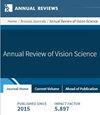弱视的最新治疗进展。
IF 5
2区 医学
Q1 NEUROSCIENCES
引用次数: 4
摘要
闭塞疗法作为治疗弱视的金标准疗法已有很长的历史。在过去的二十年里,大量的多中心随机对照试验和客观剂量监测研究描述了屈光矫正、补片和阿托品惩罚的效果,为年龄和治疗剂量等因素的影响提供了深入的了解。最近的治疗方法,其发展已被技术进步加速,旨在为弱视眼和其他眼睛提供不同的刺激。这篇综述探讨了各种这样的双视方法,根据它们是否主要具有弱视眼在面对同眼遮蔽时的必要使用、双眼视觉信息的整合或同眼刺激显著性的减少进行分类。目前尚不清楚二分法治疗是否优于传统的低成本治疗方法,或者其治疗机制是否与现有治疗方法有根本不同。《视觉科学年度评论》第8卷的最终在线出版日期预计为2022年9月。修订后的估计数请参阅http://www.annualreviews.org/page/journal/pubdates。本文章由计算机程序翻译,如有差异,请以英文原文为准。
Recent Treatment Advances in Amblyopia.
Occlusion therapy has a long history as the gold standard treatment for amblyopia. Over the past two decades, large multicenter randomized controlled trials and objective dose-monitoring studies have characterized the effects of refractive correction, patching, and atropine penalization, providing insights into the impact of factors such as age and treatment dose. More recent approaches, whose development has been accelerated by advances in technology, are designed to provide different stimulation to the amblyopic eye and the fellow eye. This review explores a variety of such dichoptic approaches, categorized according to whether they primarily feature requisite use of the amblyopic eye in the face of fellow-eye masking, integration of visual information from both eyes, or reduction of stimulus salience in the fellow eye. It is still unclear whether dichoptic treatments are superior to traditional, low-cost treatment methods or whether their therapeutic mechanisms are fundamentally different from those of established treatments. Expected final online publication date for the Annual Review of Vision Science, Volume 8 is September 2022. Please see http://www.annualreviews.org/page/journal/pubdates for revised estimates.
求助全文
通过发布文献求助,成功后即可免费获取论文全文。
去求助
来源期刊

Annual Review of Vision Science
Medicine-Ophthalmology
CiteScore
11.10
自引率
1.70%
发文量
19
期刊介绍:
The Annual Review of Vision Science reviews progress in the visual sciences, a cross-cutting set of disciplines which intersect psychology, neuroscience, computer science, cell biology and genetics, and clinical medicine. The journal covers a broad range of topics and techniques, including optics, retina, central visual processing, visual perception, eye movements, visual development, vision models, computer vision, and the mechanisms of visual disease, dysfunction, and sight restoration. The study of vision is central to progress in many areas of science, and this new journal will explore and expose the connections that link it to biology, behavior, computation, engineering, and medicine.
 求助内容:
求助内容: 应助结果提醒方式:
应助结果提醒方式:


